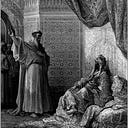A Deep Dive Into Hozier’s Francesca & The Importance of Literary References in Contemporary Music
Andrew Hozier-Byrne, famously known as Hozier, is an irish singer-songwriter that is best known from his acclaimed hit song “Take Me To Church”. In most of his works, he often uses literary or mythological references to add the fantasy and atmospheric elements of his songs.
One of the most notable examples is “From Eden”, a song he released back in 2014. “From Eden” expressed the feeling of innocence and sin at the same time. As suggested by its title, the song contains biblical references of the Garden of Eden. In the song, he used the word slithered synonymously to the serpent who tempted eve with the forbidden fruit, creating the first ever sin.
Recently, Hozier released a song called “Francesca”, which will be included in his upcoming album released later in 2023. I myself is an avid reader, I read all kind of books; fantasy, non fiction, even epics. Of course, when talking about epic literature, I would always say The Odyssey or The Iliad. Although, I sometimes say that Dante’s Divine Comedy is one of the epic tales that I personally enjoy. Sharing the story of Dante’s Divine Comedy is surely complicated. I couldn’t even describe what its like in casual conversations.
Long story short however, Dante’s Divine Comedy consists of three different sections. The first one is the most famously known: Inferno. The second one, Purgatorio (Purgatory) and the third Paradiso (Paradise). Me explaining Divine Comedy is nonsense if you ask yourself “what is the relation?” Well, the answer will be discussed later in this article. Back to Dante’s Divine Comedy, Inferno is famous for its nine circles of hell, even so that it inspired Dan Brown’s acclaimed book and its movie adaptation, Inferno. If I could summarize the plot, it’d be too much for those who haven’t read it (yes i have said it before). In the poem, Dante meets Virgil, another poet, that leads him to the journey of each circles. Basically, the circles of hell is a visual representation of where sinners go to. In this poem, Dante made references to historical figures on each circle of hell.
The lustful, for example, was placed on the second circle. In Canto V — where they reached the second circle for example, Dante and Virgil were greeted by many figures such as Cleopatra and Helen of Troy. Another long story short, Dante and Virgil then made it through all circles and proceeded to the Purgatory and eventually, Paradise. The Divine Comedy is truly a masterpiece, with many infamous works inspired by the poem.
IF you look at this article’s title, then here is the deep dive. In Hozier’s recent album, Unreal Unearth, he solely describes the Nine circles of hell into music. Although not all songs have been released, one particularly stood out for me, “Francesca”. I was looking through how Hozier had implied The Divine Comedy itself, then I realized that he made a song dedicated to a woman mentioned in Dante’s Inferno (Canto V, again). This woman is Francesca da Rimini, in which was put in the second circle of hell (The Lustful). Hozier starts the song with the lyrics:
“Do you think I’d give up? That this might’ve shook the love from me.”
This may refer to Francesca’s murder. Francesca da Rimini was married to Gianciotto (or Giovani) Malatesta. Problem occured when Francesca fell in love with her husband’s brother, Paolo. They were caught by Gianciotto by committing adultery. Outraged, he furiously murdered both his wife and brother. Because of the sudden murder, she has no time to repent her sins.
In “Francesca”, Hozier mentioned that
“When the heart would cease, ours never knew peace.”
This could be a reference on how both Francesca and Paolo never had the chance to repent their sins due to Gianciotto’s rage, or how Francesca and Gianciotto were both placed in hell, knowing that they wouldn’t make peace.
We could also see from Gianciotto’s perspective in the line
“When that part of you was ripped away, a grip takin’ hold like a cancer that grows each piece of your body that it takes.”
This suggest that Gianciotto was expressing his hurt at Francesca’s betrayal, hurting more when he knew it was Paolo who she falls in love with. In the Chorus, whether its Francesca da Rimini or Paolo, it’s clear that they didn’t regret the love they had.
Fast forward to the outro, Hozier wrote
“Heaven is not fit to house a love like you and I”
This line could possibly mean the exile of Francesca and Paolo. Hozier might be asking why they could never go to heaven, when their love is excruciatingly beautiful.
It is important for contemporary writers to understand what classic writers wrote about. Personally, having references to classic writers in their work, physically (ex. artwork) or verbally (ex. song) is important so it could push youths or even adults to have a deeper connection with what they’re seeing or listening. This could bring back reading traditions that is decreasing in this 21st century. The references could also help explain what truly writers or artists think throughout their process.
Finally, it’s an advantage to know an old reference from literature in songs, artworks, and even books. For me, it’s a flex to tell people that I get that reference (haha!).
Well, this concludes the article and to whoever reading this, thank you.
